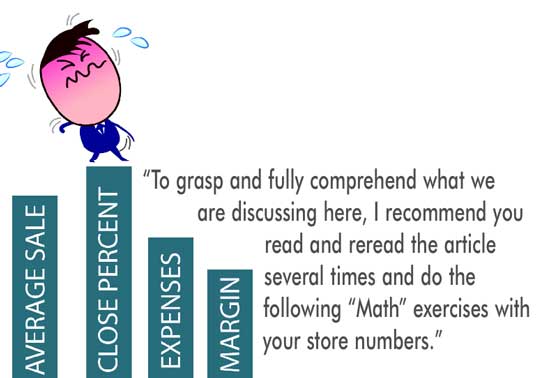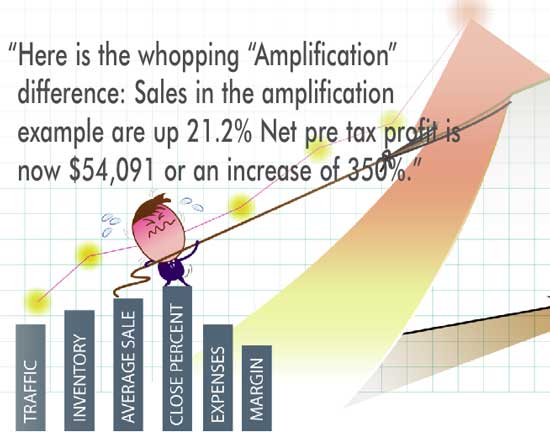Home sector retail excellence is a quest that takes enormous amounts of energy and unrelenting focus. For many retailers this quest or hunt can take years if not a lifetime. And unfortunately many of them never achieve what we would consider to be true business excellence. Since so much is riding on the details of your business, I want you to consider the ramifications of either staying completely and utterly focused, or taking your eyes off of the ball.

In this tepid economy, 90% is NOT good enough! And the difference between 95% and 100% can be staggering. Small differences in focus can make the difference between profit and loss and positive or negative cash flow.
As an owner or manager, you must be continuously and consistently focused on all key areas of your business. And, the ultimate magic trick is that you must maintain this intense focus in each area simultaneously.
In this day of immense competition and fast paced change in our industry, retailers that are unable to maintain the requisite focus and expertise in all areas will find themselves at a huge disadvantage. In fact, those lacking the knowledge, drive and desire to be the best may find themselves irrelevant in their marketplaces.
This article is among the most significant and important home sector articles you may ever read. To grasp and fully comprehend what we are discussing here, I recommend you read and reread the article several times and do the following “Math” exercises with your store numbers.
When we speak with furniture retailers we ask questions… lots of questions. That’s what teachers and analyst’s do. The responses from retail owners and managers to the following six questions never cease to amaze. Often the answers are absolutely confounding, overwhelming or downright depressing.
The Six Questions
- If your traffic were down 5% would you be concerned? Most say no. Just ripples, ups and downs in normal business.
- If your average sale were to decrease 5% would you be concerned? Most say no. Just ripples, ups and downs in normal business.
- If your close percent declined 5% would you be concerned? Most say no. Just ripples, ups and downs in normal business.
- If your margin fell 5% (5% not 5 points) would you be concerned? Most say no. Just ripples, ups and downs in normal business.
- If your inventory increased 5% would you be concerned? Most say no. Just ripples, ups and downs in normal business.
- If your expenses went up 5% would you be concerned? Most say no. Just ripples, ups and downs in normal business.
You see, alone these little changes mean very little. However when they all occur at the same time, watch out!
The point of this article is that
THE LITTLE THINGS MATTER. A friend of mine, Zig Ziglar once said, “Tell your wife she looks like the first day of spring and she will eat it up. Tell your wife she looks like the last day of a long hard winter and she will eat you up!” Again, THE LITTLE THINGS MATTER.
Let me explain. There are two principles you should become familiar with. The first is amplification and the second is attenuation. Amplification and attenuation are effects or consequences that are guaranteed to happen or occur based upon certain antecedents, causes or actions. Quite simply, these two principles are based upon the law of cause and effect.
Herein lies the danger; laws are certain and laws work for or against you whether you want them to or not. And, laws work for or against you whether you know it or not.
AMPLIFICATION
Amplification is a good thing. Amplification is where the desired end results are magnified by making small, seemingly insignificant but powerful changes in several key areas of the business. This amplification means that sales will increase and/or profitability will increase. When several positive things align or converge at the same time, they create very nice increases in key performance measures such as traffic, sales, margin and profitability. Certain causes create desired effects.
Amplification occurs by doing ALL the right things the right way at the right time.
ATTENUATION
The opposite of amplification is attenuation. Attenuation is a bad thing. Attenuation is a decrease or weakening of desired end results. For example, If you take your eye off the ball in several critical areas of your business, the results can have devastating consequences. Rather than having the law of cause and effect work for you, it works against you. With attenuation your causes have undesired effects. When several negative things align or converge at the same time, they create very bad decreases in key performance measures such as traffic, sales, margin and profitability.
AMPLIFICATION EXAMPLE
Consider a make-believe retailer with the following performance metrics.
Sales $300,000. Gross margin 44%. Expenses 40%. Net pre tax profit 4% or $12,000. Also lets consider that traffic was 600. Tickets written were 200 and the average sale was $1,500.
Now our make-believe retailer takes his or her business very seriously and has an incredible focus on ALL of the HVT High Value Targets in several key areas of the business. Here is what this retailer does to change the end results.
- Through proper advertising and marketing, traffic is up 5%
- Through proper merchandising, margins have increased 5%. Not 5 points, but 5%.
- Through proper, merchandising, sales training and coaching, the average sale increased 5% and the close percent increased 5%.
- Through proper financial management, expenses were reduced by 5%. Not 5 points, but 5%.
- NOTICE: Everything works together!
These seemingly insignificant positive changes due to increased focus, training and knowledge have amplified the retailers end results. Here are the revised numbers based upon these small changes.
Traffic is now at 660. The close percent is now 35%. The average sale is now $1,575 and overall sales are now $363,835. Expenses are now $114,000. Margins are now 46.2%.
The whopping “Amplification” difference in the amplification example is that sales are up 21.2% Net pre tax profit is now $54,091 or an increase of 350%.
ATTENUATION EXAMPLE
So what happens if this make-believe retailer takes his or her eyes off the ball? Small seemingly insignificant decreases in focus can create immense downturns in key numbers especially bottom-line profitability.
Now our make-believe retailer takes his or her business LESS seriously and has a diminished focus on the HVT High Value Targets in several key areas of the business. Here is what this retailer does to change the end results.
- Through poor ineffective advertising and marketing, traffic is down 5%.
- Through weak merchandising, margins have decreased 5%. Not 5 points, but 5%.
- Through poor merchandising, sales training and coaching, the average sale decreased 5% and the close percent is down by 5%.
- Through poor financial management, expenses increased by 5%. Not 5 points, but 5%.
These seemingly insignificant changes due to lack of focus, poor training and perhaps not having required skill sets have amplified in the negative, creating attenuation of the retailers end results. Here are the revised numbers based upon these small changes.
Traffic is now at 570. The close percent is now 31.6%. The average sale is now $1,425 and overall sales are now $256,671. Expenses are now $126,000. Margins are now 41.8%
Here is the incredible attenuated difference: Sales in the attenuation example are down 14.4% Net pre tax profit is now actually a loss of $18,711.
This focus or lack thereof, knowledge or lack thereof creates a swing in profitability of $72,802 for this small retailer.
The small differences will work for or against you, whether you want them to or not, and whether you know about them or not.
Here is your homework: Take your own stores’ performance numbers and insert them into these two scenarios. Work out the math and see what happens. It will blow you away.
Now consider cash flow rather than profitability. What if you experience an increase in inventory along with these little slides in close percent, margin, traffic etc., combined with increases in expenses? All of a sudden you have the recipe for spiraling or non-existent cash flow. Unless you have deep pockets, this is a dying business model. And, if you don’t care because you have deep pockets, this is an ignorant business model.

Do it now… Look after the little things. The HVT High Value Targets of a successful home sector retailer.
Next issue: In the next issue we will discuss the top 10 HVT High Value Targets you must master to make amplification work for you.
Founder of Integrity Business Coaching, Hal McClamma has over 30-years in the home furnishings, appliance and electronics industry. He has owned successful furniture stores and sleep shops. McClamma has been a distribution center manager, single and multiple store manager and company VP for Havertys Furniture, Barrow Furniture, Maas Brothers, Burdines and Jordan Marsh. Contact Hal at Hal@IntegrityBusinessCoaching.com or call 334.470.9999.